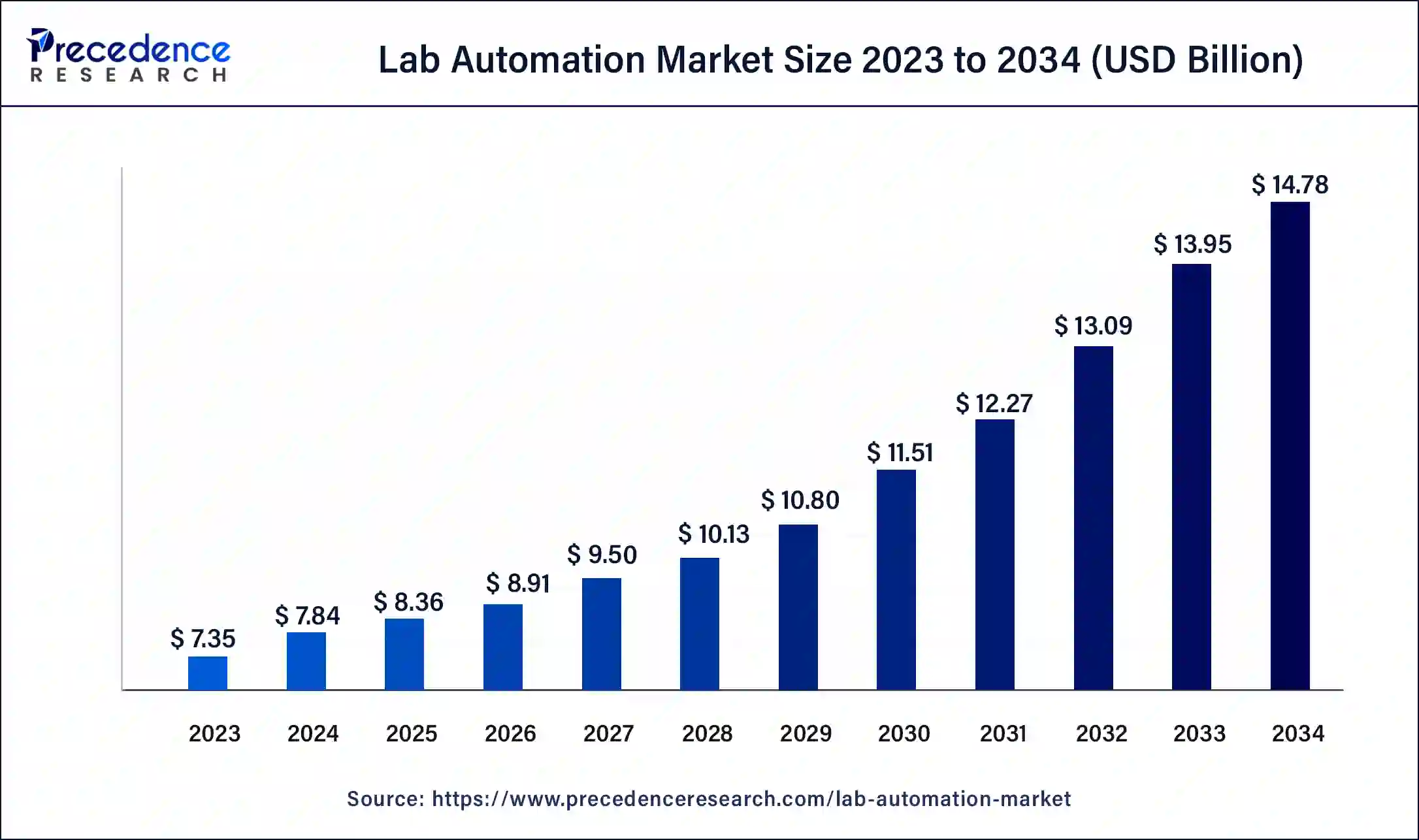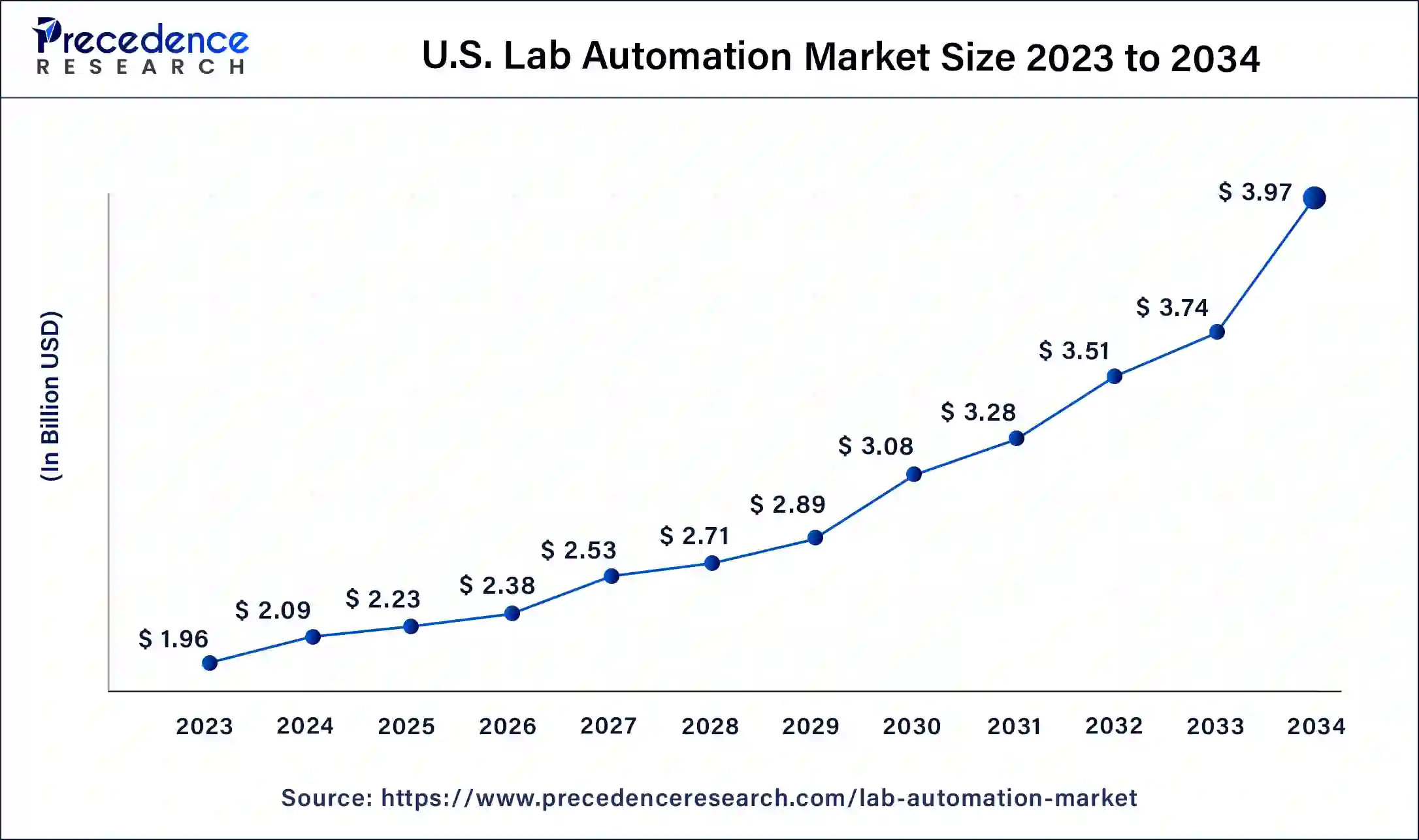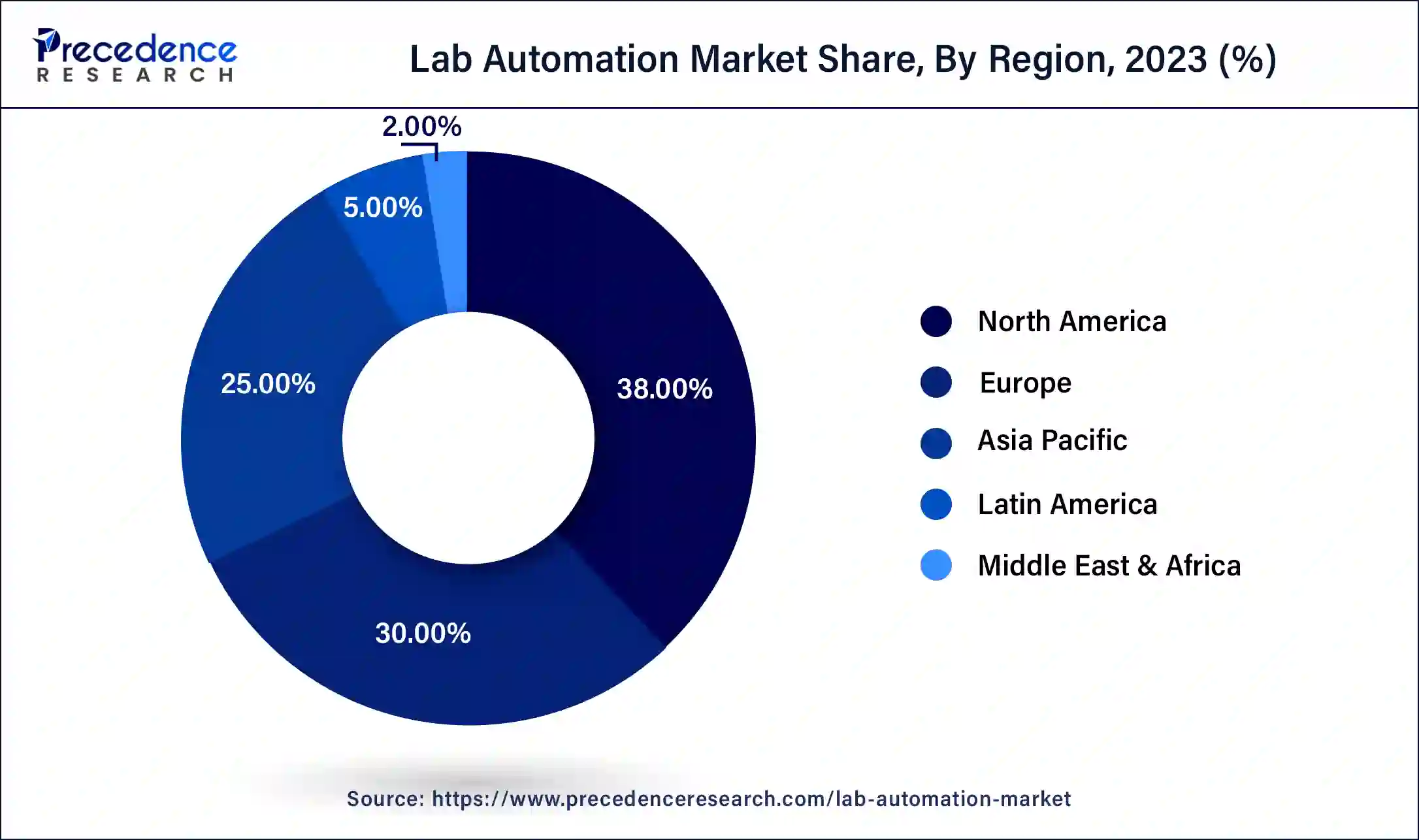January 2025
The global lab automation Market size was USD 7.35 billion in 2023, estimated at USD 7.84 billion in 2024 and is anticipated to reach around USD 14.78 billion by 2034, expanding at a CAGR of 6.55% from 2024 to 2034.
The global lab automation market size accounted for USD 7.84 billion in 2024 and is predicted to reach around USD 14.78 billion by 2034 growing at a CAGR of 6.55% from 2024 to 2034. The North America lab automation market size reached USD 2.79 billion in 2023.

The U.S. lab automation market size was valued at USD 1.96 billion in 2023 and is expected to be worth around USD 3.97 billion by 2033, at a CAGR of 7% from 2024 to 2034.

North America has held the largest revenue share in 2023. The North America lab automation market thrives as a dynamic sector in the laboratory technology and life sciences landscape. This region comprises economic powerhouses, namely the United States and Canada, which lead the way in technological innovation and research-driven industries. Their contributions significantly fuel the growth and development of lab automation. With well-established infrastructure including research institutions, healthcare facilities, pharmaceutical companies, biotechnology firms, and clinical laboratories, North America increasingly relies on lab automation solutions to enhance productivity, accuracy, and efficiency.
Lab automation has become increasingly popular in North America due to various factors. These include the continuous focus on drug discovery and development, the rising demand for personalized medicine, and the necessity for speedy and dependable diagnostic testing. Among these factors, the pharmaceutical sector stands out as a major driving force, constantly exploring avenues to expedite the drug development pipeline.

The Asia-Pacific lab automation market is experiencing remarkable growth and transformation. The region comprising countries like China, India, Japan, South Korea, and Australia has gained significant recognition in global scientific research, pharmaceuticals, biotechnology, and healthcare. This demonstrates the increasing prominence of this region in these fields. Each of these countries significantly contributes to the expansion of lab automation technologies. Moreover, the Asia-Pacific region features a flourishing pharmaceutical industry that heavily invests in drug discovery, development, and production. Consequently, there is a rising adoption of lab automation systems to streamline processes and enhance research efficiency.
Technological innovation and research collaborations further shape the Asia-Pacific Lab Automation Market. Government initiatives, academic institutions, and industry partnerships are driving advancements in automation and robotics. This progress becomes particularly evident in countries like Japan and South Korea. As these regions go through economic growth and invest in cutting-edge technologies, the Asia-Pacific lab automation market is projected to witness significant expansion.
The lab automation market encompasses a wide range of automated systems, instruments, software, and workflows. The purpose of this solution is to streamline and enhance laboratory processes, data management, and experimentation in various scientific domains. These encompass pharmaceuticals, biotechnology, clinical diagnostics, academic research, and healthcare. The key goal of lab automation solutions is to reduce human intervention while improving accuracy, increasing throughput, and optimizing resource utilization.
The lab automation market comprises several essential components such as robotic systems, liquid handling devices, automated analyzers, sample preparation equipment. Additionally, there are integrated software platforms that enable seamless control and monitoring of laboratory operations. With advancements in robotics AI & data analytics technology fields are boosting the lab automation market by revolutionizing research and development practices. Ultimately it enables faster drug discovery procedures alongside diagnostic testing methodologies for genomics and personalized medicine.
The lab automation industry is currently evolving significantly. In particular, the integration of advanced technologies such as Internet of Things, lab microfluidics and chip devices have led to significant transformation in this sector. By presenting new solutions to improve effectiveness, reproducibility and scaling, this convergence has a fundamental influence on the pursuit of science. As laboratories across different sectors increasingly acknowledge the advantages of automation, the lab automation market is projected to experience substantial growth in the future. Its role will be instrumental in driving advancements in scientific discovery and healthcare solutions.
The demand for improved efficiency and productivity in research and development is growing across various industries, such as pharmaceuticals, biotechnology, and healthcare. Lab automation systems offer a solution by significantly reducing manual labor, minimizing errors, and speeding up experimental processes. This increased efficiency leads to quicker results, cost reduction, and enhanced competitiveness. Consequently, organizations seeking an advantage in a highly competitive landscape find automation to be an appealing option.
Furthermore, the lab automation market, in particular the robotics and artificial intelligence markets, is benefiting from technological progress. The development of more sophisticated and flexible laboratory automation systems has been facilitated by these remarkable developments. Robotic platforms are now capable of handling intricate tasks like high-throughput screening, sample preparation, and even conducting experiments themselves. Additionally, AI algorithms enable optimized workflows, predictive analytics, and real-time adaptability to changing experimental conditions. These extensive capabilities elevate lab automation systems' adaptability across a broad spectrum of laboratory applications.
Therefore, the lab automation market is witnessing continuous growth. The growth observed can be attributed to the increasing demands for efficiency, data management, technological advancements, and breakthroughs in scientific disciplines. As laboratories strive for enhanced capabilities and competitiveness, lab automation solutions are poised to play a crucial role in shaping the future of research and development across multiple industries.
| Report Coverage | Details |
| Growth Rate from 2024 to 2034 | CAGR of 6.55% |
| Market Size in 2023 | USD 7.35 Billion |
| Market Size in 2023 | USD 7.84 Billion |
| Market Size by 2033 | USD 13.96 Billion |
| Largest Market | North America |
| Base Year | 2023 |
| Forecast Period | 2024 to 2034 |
| Segments Covered | Process, Automation Type, End-User, and Region |
| Regions Covered | North America, Europe, Asia-Pacific, Latin America, and Middle East & Africa |
Data management challenges
In today's research and laboratory environments, the generation of vast volumes of data has become a common occurrence. This is primarily due to advancements in high-throughput technologies, omics sciences, and complex experimentation. These datasets hold immense potential for groundbreaking discoveries and innovations.
However, the manual management, processing, and analysis of such data proves to be time-consuming and prone to errors, thereby creating a bottleneck in the research process itself. To tackle these challenges head-on, lab automation systems equipped with powerful software and algorithms offer an effective solution. These systems seamlessly integrate with various laboratory instruments, allowing for real-time data collection and standardized formats that guarantee consistency and accuracy.
In addition, the utilization of lab automation systems has a remarkable impact on the speed of research. Without constant manual intervention, researchers can conduct experiments on a large scale, enabling quicker data generation and facilitating faster insights and decision-making. This is especially crucial in fields such as genomics, drug discovery, and clinical diagnostics where timely results hold significant importance for patient care and scientific progress.
Therefore, the challenges of managing data in modern laboratories are continuously expanding. These challenges have become a key driver behind the growth of the lab automation market. By addressing issues related to data volume, quality, and efficiency, lab automation systems allow researchers to fully utilize their data's potential. This ultimately leads to faster scientific discoveries and innovations across various industries. As research generates unprecedented amounts of data, the demand for effective data management solutions through lab automation is anticipated to grow even further in the future.
Lack of skilled workforce
The demand for skilled personnel who can design, operate, maintain, and troubleshoot increasingly complex and technologically advanced laboratory automation systems has grown alongside their rapid development. However, a notable scarcity of individuals with expertise in robotics, software programming, and automation-specific knowledge poses challenges in various regions and industries. This dearth of skilled labor hinders the seamless adoption and effective utilization of cutting-edge automation technology. Laboratories investing in such technology may struggle to maximize its benefits without personnel capable of harnessing its full potential.
Furthermore, this skill gap can result in operational inefficiencies, increased downtime due to technical issues, and a diminished return on investment. Researchers and laboratory staff who lack sufficient training in working with automation systems may exhibit resistance towards their adoption or utilize them sub-optimally. This resistance or sub-optimal use can lead to a diminished impact on scientific productivity and innovation. The lack of skilled workforce poses a significant challenge for the lab automation market. This challenge has the potential to hinder its growth and broader adoption.
As automation technology continues to advance and play a more integral role in laboratory operations, it becomes crucial to take measures in cultivating a workforce equipped with the necessary skills and knowledge. Only then can we fully leverage the innovative systems' true potential. Overcoming this restraint is essential in realizing the promised benefits of efficiency, accuracy, and productivity that lab automation offers.
Biotechnology advancements
Biotechnology has seen a remarkable shift due to the advancements in genomics, proteomics, cell biology, and molecular biology. This progress has resulted in a greater need for sophisticated laboratory equipment and biotechnology-related items. At the forefront of this transformation are lab automation systems. These systems provide a solution to the growing complexity and scale of experiments in biotechnology.
Lab automation systems empower researchers to handle large volumes of biological samples, perform high-throughput assays, and conduct precise liquid handling with unparalleled accuracy and consistency. Achieving such precision manually poses considerable challenges. In the field of genomics specifically, automating DNA sequencing, library preparation, and next-generation sequencing workflows has substantially expedited progress in genomic research as well as personalized medicine. High-throughput screening and automated cell culture systems are now essential in drug discovery and bioprocessing.
They enable rapid compound testing and large-scale production of biopharmaceuticals. Additionally, automation has streamlined complex procedures like protein purification and analysis. As a result, research in proteomics and structural biology has advanced significantly, leading to a deeper understanding of proteins and their functions.
Biotechnology is continuously evolving, driving the demand for lab automation solutions. These solutions must be capable of handling diverse biological assays while ensuring data integrity and enhancing research reproducibility. Moreover, the integration of biotechnology with data analytics and artificial intelligence introduces exciting possibilities for automation providers. They can now develop integrated systems that not only generate data but also assist in its interpretation and analysis.
The synergistic relationship between biotechnology and lab automation positions the latter as a crucial catalyst for advancements in this field. It opens doors to groundbreaking discoveries, novel therapies, and personalized medicine applications that will shape the future of healthcare and life sciences. As the biotech industry pushes forward scientific knowledge boundaries and explores new therapeutic possibilities, this synergy will continue to drive innovation and fuel market growth.
Impact of COVID-19
The lab automation industry has been profoundly affected by the COVID-19 pandemic. In response to this unprecedented global health crisis, laboratories worldwide faced an urgent need for increased testing capacity, high-throughput screening, and diagnostic capabilities. To meet these demands, lab automation played a pivotal role by employing automated systems that facilitated rapid processing of COVID-19 tests, sample handling, and data analysis. As a result of this surge in demand for automation in clinical and diagnostic laboratories, there was a significant boost in the adoption of automated platforms, robotics, and liquid handling systems.
Furthermore, the pandemic has highlighted the crucial significance of flexibility and adaptability in laboratory automation solutions. Laboratories were swiftly compelled to address emerging challenges that included new variations of the virus and evolving testing requirements. Consequently, this circumstance has driven notable advancements in automation technology. Providers have been motivated to develop more versatile and modular systems that can be rapidly reconfigured to effectively accommodate changing needs.
According to the process, the continuous flow sector has held the major revenue share in 2023. The lab automation market has introduced a groundbreaking approach called continuous flow segment, revolutionizing laboratory processes. This innovative method offers significant advantages in terms of efficiency, precision, and scalability. Unlike traditional batch processing, continuous flow systems allow for uninterrupted and sequential execution of experiments or assays. Essentially, samples move continuously through different stages of the process.
This approach has gained widespread recognition within various applications including chemical synthesis, drug discovery, and clinical diagnostics. Continuous flow systems excel at maximizing resource utilization, minimizing waste generation, and optimizing reaction conditions. Take chemical synthesis for example; microfluidic-based continuous flow platforms enable precise control over reaction parameters leading to improved product yields and reduced reaction times. In pharmaceutical research, the rapid development of new drug candidates is essential.
The modular automation system segment held the largest market share the market in 2023. Modular systems possess a key characteristic: flexibility. This feature allows laboratories to customize and reconfigure their automation setups based on specific research needs and workflows. These systems are composed of individual, interchangeable modules or components that can be easily integrated or expanded upon. As a result, they are exceptionally well-suited for laboratories with evolving requirements or those seeking to optimize existing workflows.
Furthermore, modular automation offers enhanced versatility, enabling researchers to perform a wide range of tasks within a single integrated system—ranging from sample preparation to data analysis. Such adaptability holds particular value in research environments where experiments may vary significantly in complexity and scope. By configuring their automation system accordingly, scientists gain the advantage of automating routine and repetitive tasks, thereby freeing up valuable time for more intricate and creative aspects of their work.
In 2023, the clinical chemistry analysis sector had the highest market share on the basis of the end-user. The field of clinical chemistry analysis entails a wide array of automated systems. These specialized systems are designed to perform clinical chemistry tests, immunoassays, and biochemical analyses with remarkable precision, speed, and accuracy. By automating key processes like sample preparation, reagent handling, mixing, incubation, and result reporting, these systems significantly reduce manual labor requirements while enhancing the reliability of test results.
Their vital role in medical diagnostics lies in providing crucial information about a patient's overall health, organ function, and disease markers. Clinical chemistry analysis systems are particularly valuable for measuring biomarkers, electrolytes enzymes hormones metabolites. This capability greatly aids in diagnosing and monitoring conditions such as diabetes liver disease cardiovascular disorders infectious diseases. The automation of clinical chemistry testing has two significant benefits. This technology enhances testing efficiency, resulting in higher throughput. Additionally, it reduces the likelihood of human error, which ultimately improves patient care and facilitates more accurate treatment decisions.
Segments Covered in the Report:
By Process
By Automation Type
By End-User
By Geography
For inquiries regarding discounts, bulk purchases, or customization requests, please contact us at sales@precedenceresearch.com
No cookie-cutter, only authentic analysis – take the 1st step to become a Precedence Research client
January 2025
October 2024
November 2024
October 2024